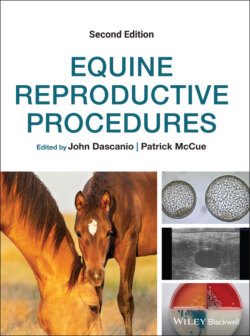Читать книгу Equine Reproductive Procedures - Группа авторов - Страница 49
Fungal Organisms
ОглавлениеYeast are typically 5–8 μm in size with a very distinct cell wall (100–200 nm) that forms a clear “halo” around the organism; this may be especially evident if the organism is surrounded by debris or other cells (Figure 17.9).
Hyphate fungi are typically 3–5 μm in width and 8 μm in length. These individual cells are commonly linked together in long branching chains (Figures 17.10 and 17.11). In many instances, detection of a fungal organism on cytologic examination may be the only evidence of fungal endometritis, as organisms do not always grow on culture.
Figure 17.7 Chains of cocci (arrow) in a uterine cytology sample collected from a mare with a Streptococcus equi subspecies zooepidemicus infection.
Figure 17.8 Gram‐negative rods (arrow) in a uterine cytology sample collected from a mare with endometritis.
Figure 17.9 Yeast organisms (Candida albicans) (arrow) in a uterine cytology sample.
Figure 17.10 Aspergillus fumigatus organisms in a mare with fungal endometritis.
Figure 17.11 Yeast (large arrow) and hyphae (small arrow) with neutrophils in a mare with fungal endometritis.
